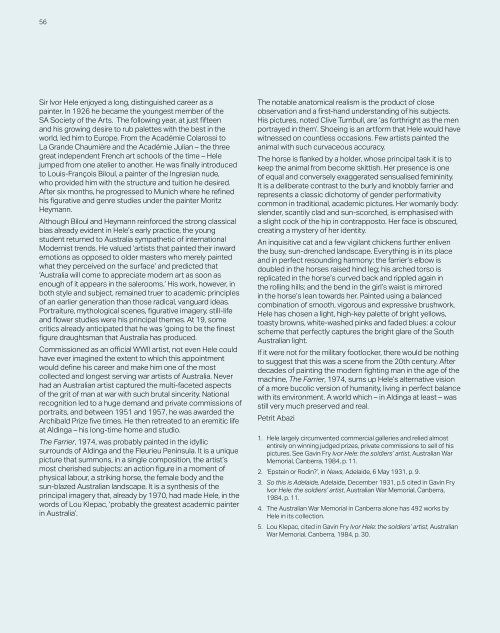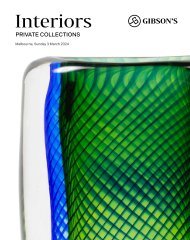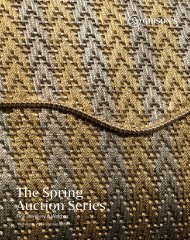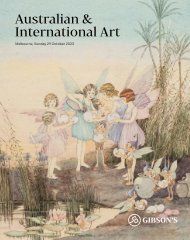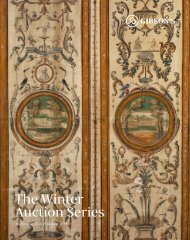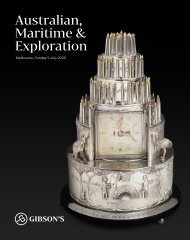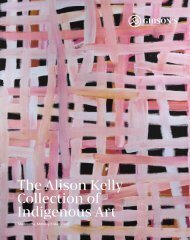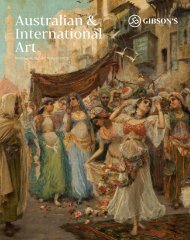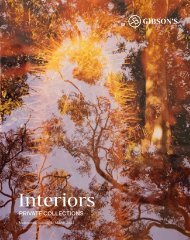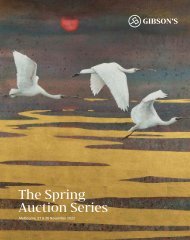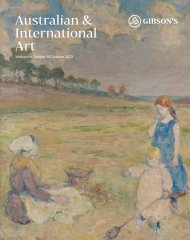GA019 | Australian & International Art
You also want an ePaper? Increase the reach of your titles
YUMPU automatically turns print PDFs into web optimized ePapers that Google loves.
56<br />
Sir Ivor Hele enjoyed a long, distinguished career as a<br />
painter. In 1926 he became the youngest member of the<br />
SA Society of the <strong>Art</strong>s. The following year, at just fifteen<br />
and his growing desire to rub palettes with the best in the<br />
world, led him to Europe. From the Académie Colarossi to<br />
La Grande Chaumière and the Académie Julian – the three<br />
great independent French art schools of the time – Hele<br />
jumped from one atelier to another. He was finally introduced<br />
to Louis-François Biloul, a painter of the Ingresian nude,<br />
who provided him with the structure and tuition he desired.<br />
After six months, he progressed to Munich where he refined<br />
his figurative and genre studies under the painter Moritz<br />
Heymann.<br />
Although Biloul and Heymann reinforced the strong classical<br />
bias already evident in Hele’s early practice, the young<br />
student returned to Australia sympathetic of international<br />
Modernist trends. He valued ‘artists that painted their inward<br />
emotions as opposed to older masters who merely painted<br />
what they perceived on the surface’ and predicted that<br />
‘Australia will come to appreciate modern art as soon as<br />
enough of it appears in the salerooms.’ His work, however, in<br />
both style and subject, remained truer to academic principles<br />
of an earlier generation than those radical, vanguard ideas.<br />
Portraiture, mythological scenes, figurative imagery, still-life<br />
and flower studies were his principal themes. At 19, some<br />
critics already anticipated that he was ‘going to be the finest<br />
figure draughtsman that Australia has produced.<br />
Commissioned as an official WWII artist, not even Hele could<br />
have ever imagined the extent to which this appointment<br />
would define his career and make him one of the most<br />
collected and longest serving war artists of Australia. Never<br />
had an <strong>Australian</strong> artist captured the multi-faceted aspects<br />
of the grit of man at war with such brutal sincerity. National<br />
recognition led to a huge demand and private commissions of<br />
portraits, and between 1951 and 1957, he was awarded the<br />
Archibald Prize five times. He then retreated to an eremitic life<br />
at Aldinga – his long-time home and studio.<br />
The Farrier, 1974, was probably painted in the idyllic<br />
surrounds of Aldinga and the Fleurieu Peninsula. It is a unique<br />
picture that summons, in a single composition, the artist’s<br />
most cherished subjects: an action figure in a moment of<br />
physical labour, a striking horse, the female body and the<br />
sun-blazed <strong>Australian</strong> landscape. It is a synthesis of the<br />
principal imagery that, already by 1970, had made Hele, in the<br />
words of Lou Klepac, ‘probably the greatest academic painter<br />
in Australia’.<br />
The notable anatomical realism is the product of close<br />
observation and a first-hand understanding of his subjects.<br />
His pictures, noted Clive Turnbull, are ‘as forthright as the men<br />
portrayed in them’. Shoeing is an artform that Hele would have<br />
witnessed on countless occasions. Few artists painted the<br />
animal with such curvaceous accuracy.<br />
The horse is flanked by a holder, whose principal task it is to<br />
keep the animal from become skittish. Her presence is one<br />
of equal and conversely exaggerated sensualised femininity.<br />
It is a deliberate contrast to the burly and knobbly farrier and<br />
represents a classic dichotomy of gender performativity<br />
common in traditional, academic pictures. Her womanly body:<br />
slender, scantily clad and sun-scorched, is emphasised with<br />
a slight cock of the hip in contrapposto. Her face is obscured,<br />
creating a mystery of her identity.<br />
An inquisitive cat and a few vigilant chickens further enliven<br />
the busy, sun-drenched landscape. Everything is in its place<br />
and in perfect resounding harmony: the farrier’s elbow is<br />
doubled in the horses raised hind leg; his arched torso is<br />
replicated in the horse’s curved back and rippled again in<br />
the rolling hills; and the bend in the girl’s waist is mirrored<br />
in the horse’s lean towards her. Painted using a balanced<br />
combination of smooth, vigorous and expressive brushwork,<br />
Hele has chosen a light, high-key palette of bright yellows,<br />
toasty browns, white-washed pinks and faded blues: a colour<br />
scheme that perfectly captures the bright glare of the South<br />
<strong>Australian</strong> light.<br />
If it were not for the military footlocker, there would be nothing<br />
to suggest that this was a scene from the 20th century. After<br />
decades of painting the modern fighting man in the age of the<br />
machine, The Farrier, 1974, sums up Hele’s alternative vision<br />
of a more bucolic version of humanity, living in perfect balance<br />
with its environment. A world which – in Aldinga at least – was<br />
still very much preserved and real.<br />
Petrit Abazi<br />
1. Hele largely circumvented commercial galleries and relied almost<br />
entirely on winning judged prizes, private commissions to sell of his<br />
pictures. See Gavin Fry Ivor Hele: the soldiers’ artist, <strong>Australian</strong> War<br />
Memorial, Canberra, 1984, p. 11.<br />
2. ‘Epstein or Rodin?’, in News, Adelaide, 6 May 1931, p. 9.<br />
3. So this is Adelaide, Adelaide, December 1931, p.5 cited in Gavin Fry<br />
Ivor Hele: the soldiers’ artist, <strong>Australian</strong> War Memorial, Canberra,<br />
1984, p. 11.<br />
4. The <strong>Australian</strong> War Memorial in Canberra alone has 492 works by<br />
Hele in its collection.<br />
5. Lou Klepac, cited in Gavin Fry Ivor Hele: the soldiers’ artist, <strong>Australian</strong><br />
War Memorial, Canberra, 1984, p. 30.


